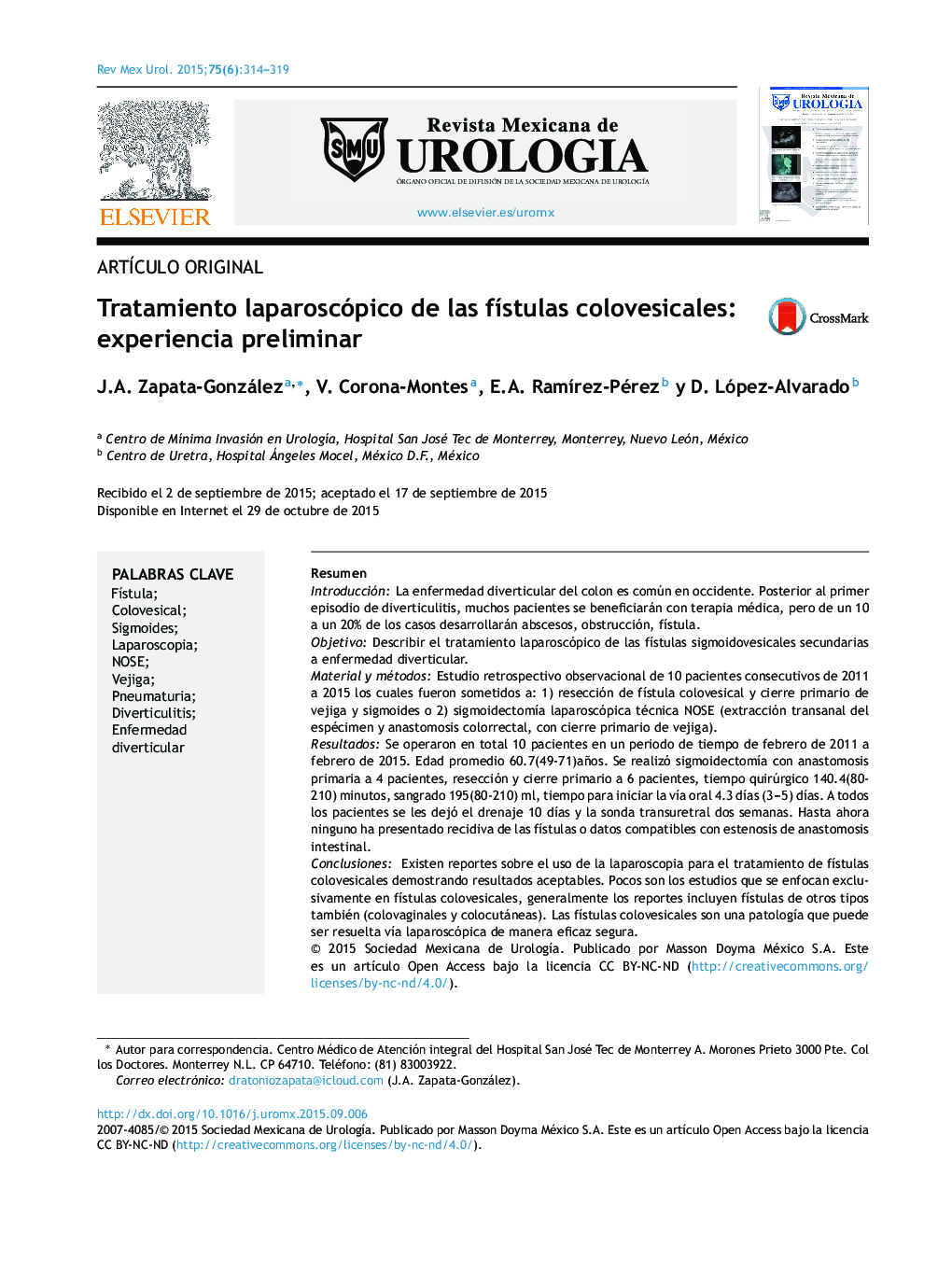| Article ID | Journal | Published Year | Pages | File Type |
|---|---|---|---|---|
| 4274387 | Revista Mexicana de Urología | 2015 | 6 Pages |
ResumenIntroducciónLa enfermedad diverticular del colon es común en occidente. Posterior al primer episodio de diverticulitis, muchos pacientes se beneficiarán con terapia médica, pero de un 10 a un 20% de los casos desarrollarán abscesos, obstrucción, fístula.ObjetivoDescribir el tratamiento laparoscópico de las fístulas sigmoidovesicales secundarias a enfermedad diverticular.Material y métodosEstudio retrospectivo observacional de 10 pacientes consecutivos de 2011 a 2015 los cuales fueron sometidos a: 1) resección de fístula colovesical y cierre primario de vejiga y sigmoides o 2) sigmoidectomía laparoscópica técnica NOSE (extracción transanal del espécimen y anastomosis colorrectal, con cierre primario de vejiga).ResultadosSe operaron en total 10 pacientes en un periodo de tiempo de febrero de 2011 a febrero de 2015. Edad promedio 60.7(49-71)años. Se realizó sigmoidectomía con anastomosis primaria a 4 pacientes, resección y cierre primario a 6 pacientes, tiempo quirúrgico 140.4(80-210) minutos, sangrado 195(80-210) ml, tiempo para iniciar la vía oral 4.3 días (3–5) días. A todos los pacientes se les dejó el drenaje 10 días y la sonda transuretral dos semanas. Hasta ahora ninguno ha presentado recidiva de las fístulas o datos compatibles con estenosis de anastomosis intestinal.ConclusionesExisten reportes sobre el uso de la laparoscopia para el tratamiento de fístulas colovesicales demostrando resultados aceptables. Pocos son los estudios que se enfocan exclusivamente en fístulas colovesicales, generalmente los reportes incluyen fístulas de otros tipos también (colovaginales y colocutáneas). Las fístulas colovesicales son una patología que puede ser resuelta vía laparoscópica de manera eficaz segura.
BackgroundDiverticular disease of the colon is common in the western world. After the first episode of diverticulitis, many patients benefit from medical therapy, but 10-20% develop abscesses, obstruction, or fistula.AimTo describe the laparoscopic treatment of sigmoidovesical fistula secondary to diverticular disease.Material and methodsAn observational, retrospective study was conducted on 10 consecutive patients within the time frame of 2011-2015 that had undergone: 1) colovesical fistula resection and primary closure of the bladder and sigmoid colon or 2) laparoscopic sigmoidectomy with the NOSE technique (transanal extraction of the specimen and colorectal anastomosis with primary closure of the bladder).ResultsTen patients were operated on within the time frame of February 2011 and February 2015. The mean age of the patients was 60.7(49-71) years. Sigmoidectomy with primary anastomosis was performed on 4 patients and resection and primary closure on 6 patients. Surgery duration was 140.4 (80-210) min, blood loss was 195 (80-210) ml, and length of time before beginning oral diet was 4.3 (3–5) days. The drain was left in place in all the patients for 10 days and the transurethral catheter for 2 weeks. Up to the present time, none of the patients has presented with fistula recurrence or data consistent with intestinal anastomosis stricture.ConclusionsReports on the use of laparoscopy for the treatment of colovesical fistulas have demonstrated acceptable results. Only a few studies concentrate exclusively on colovesical fistula; in general the reports include other types of fistula (colovaginal and colocutaneous), as well. Colovesical fistula is a pathology that can be resolved safely and efficaciously through laparoscopy.
